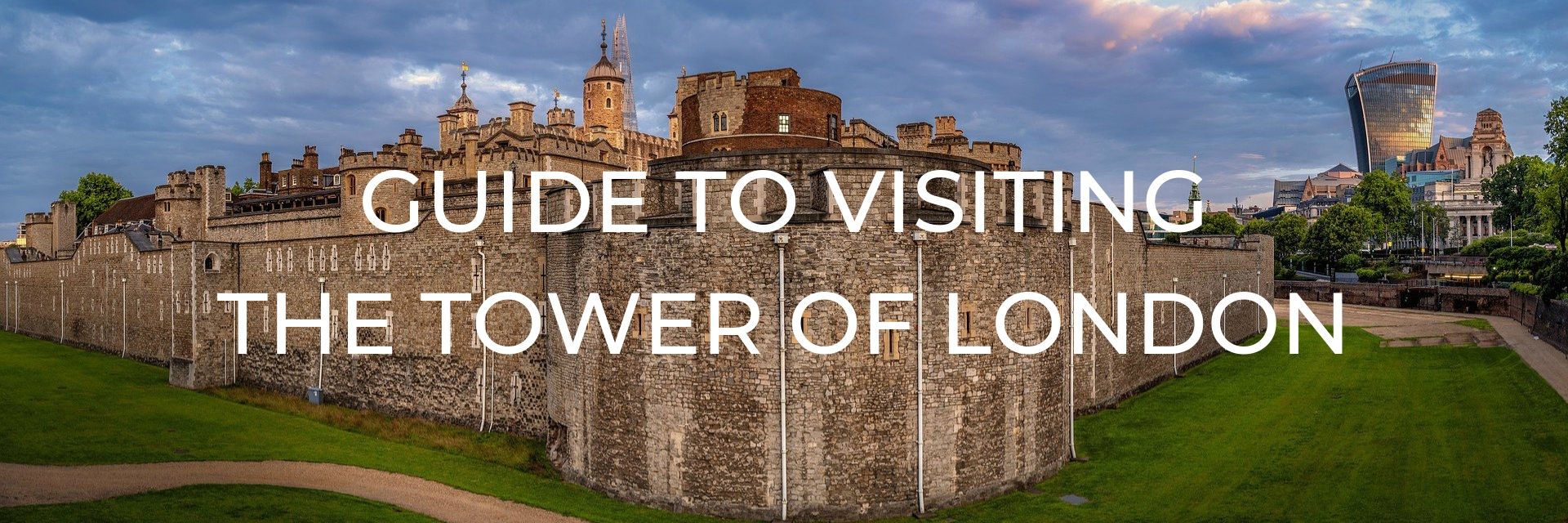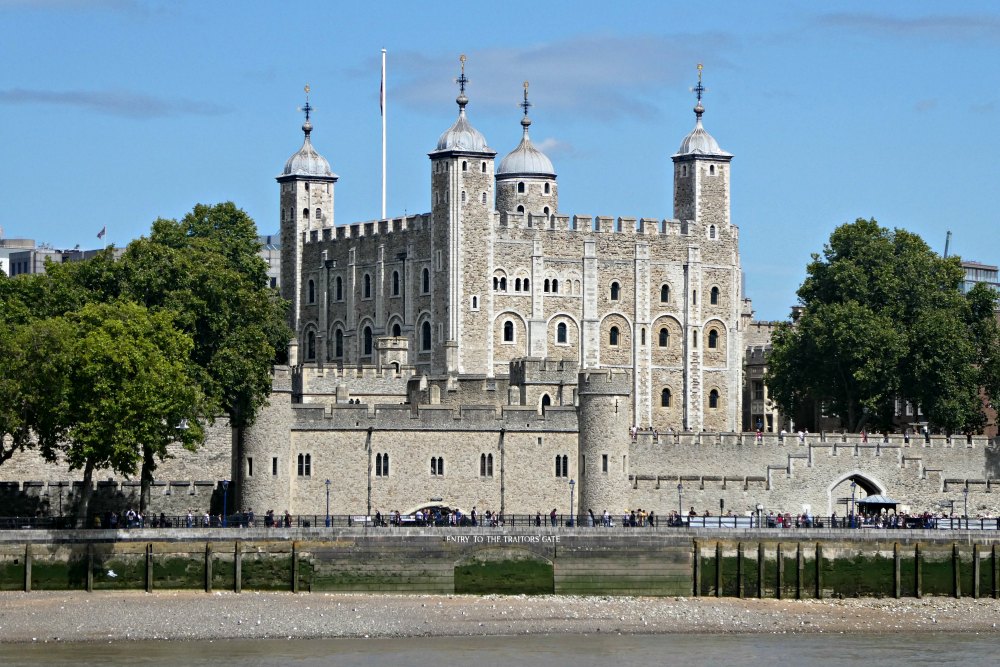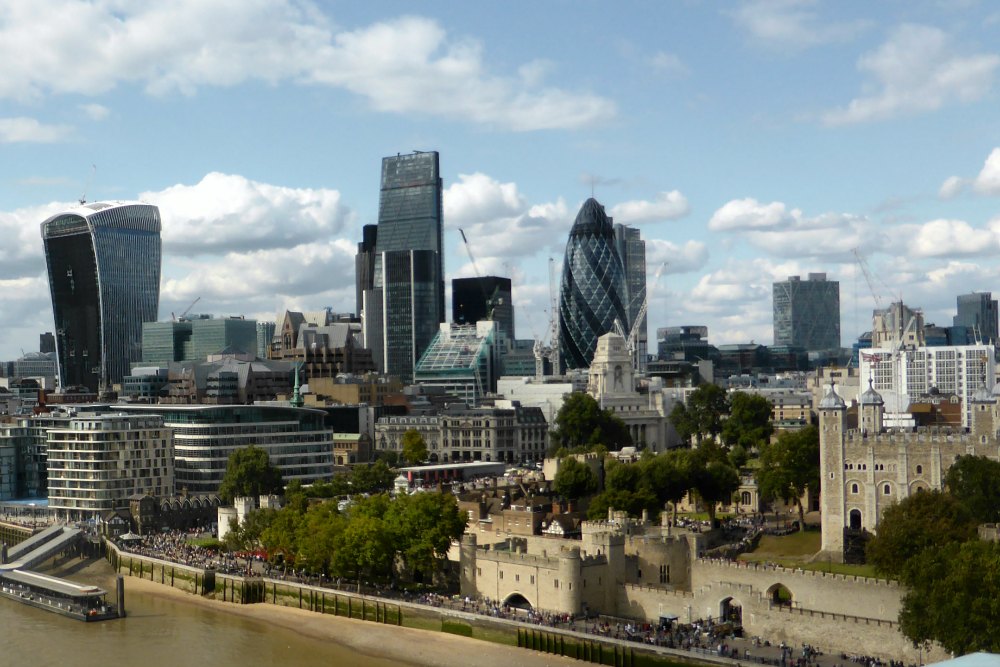
Construction began on the Tower of London in 1066 by William the Conqueror as a means to keep hostile Londoners at bay, and since then it has seen the good, the bad, and the ugly of London.
Over the past 1000 years it has been a prison, with its most famous inmates including two young princes (who were presumably murdered), Anne Boleyn (who was then beheaded on Tower Green), Lady Jane Grey (only queen for nine days and then she too was executed), Princess Elizabeth (who thankfully survived and went on to become Queen Elizabeth I), and Guy Fawkes who was tortured at the Tower following the failed Gunpowder Plot.
Want to save this for later? Click the Pinterest button on the left for a pinnable image!

In addition to prison, the Tower of London has also been a palace, held a royal menagerie (including a polar bear that was said to like to fish in the Thames!), a munitions store during the Civil War (1642-49), and a recruitment and training site for troops during WWI.
Finally, today it plays a touristic role giving countless visitors a walk through history each year when they visit. So important is its significance that it was designated a UNESCO World Heritage Site in 1988 and is now a symbol of not just London, but also a millennium of English history.
HIGHLIGHTS OF THE TOWER OF LONDON
With stories from over 1000 years of history, you can imagine there would be a lot to see at the Tower. And there is! Here are some of the highlights to get you started when planning your trip to the Tower of London.

YEOMAN WARDER TOURS
To really understand the Tower and its history, we think a guided tour with one of the Yeoman Warders is a must-do. Sometimes called “Beefeaters” (due to the large rations of beef given to them in the past), they have been a part of the Tower’s history since 1485 and today their official role is to guard the Tower and the Crown Jewels.
To qualify for this role they must have served at least 22 years in the Armed Forces and have earned a Long Service and Good Conduct Medal. Once they have earned the role, they also earn a place to live within the Tower’s outer walls! Few people likely realise the Tower of London is like a miniature village and may be surprised to see the Yeoman Warder’s washing hanging out on the line beside the castle walls.
The Yeoman Warders lead daily hour-long tours which are included in the admission price. The tours leave from just inside the portcullis in the Middle Tower every 30 minutes. The tours are entertaining with lots of tales of beheadings and torture, but also they are informative so you will learn about the history of the Tower.
If you’d rather proceed at your own pace, you can also pick up an audio-guide for £4.00 (though try to get one early as they can run out during peak season), or there are official guidebooks for sale (£4.99) to read about the Tower and its history.

THE WHITE TOWER
The most recognizable building in the complex, the White Tower is a Norman tower with a turret on each of its four corners and a golden weather vane that spins atop each turret. It is the original royal palace of the Tower of London, but it hasn’t been used as a royal residence since 1603.
The White Tower includes a few remnants of its Norman architecture, including a fireplace and a garderobe (toilet), but mainly the interior is now a museum. The exhibits from the Royal Armouries include a collection of cannons, guns, medieval weapons, and suits of armour – including a suit of armour that once belonged to Henry VIII.
The original moat was drained of disease-ridden sewage in the 19th century because of the persistent cholera outbreaks; today there is a dry moat in its place that is used for different events.
PLEASE NOTE: There are about 100 stairs to climb to tour the White Tower, some of which are quite steep and uneven.
CROWN JEWELS TREASURY
Visitors may think the Crown Jewels are the Queen’s personal collection, but they are actually the ceremonial regalia used during Coronation ceremonies. The collection also includes items other than jewellery, such as candlesticks, trumpets, swords, and the Grand Punch Bowl (which is the mother of all punch bowls!).
A very slow-moving travellator takes you past the exhibits including the Sceptre and the Imperial State Crown, which contains a famous diamond known as the Star of Africa. The Crown Jewels aren’t actually insured, because they could never be replaced.
TIP: Due to limited capacity and popularity, there is very frequently a line to enter the building to see the Crown Jewels. If you arrive early, check here first to see if there is a line and if not, grab your opportunity to get in with minimal wait time. Many people start with the Yeoman Warder tour since it is near the entrance, but you can easily come back to the entrance and join another tour later on your visit.

TOWER GREEN AND THE RAVENS
Along the green, you can see a collection of black-and-white half-timbered Tudor houses (some with Yeoman Warders standing guard outside) that are home to the Tower of London staff.
The green is also where you will find the Scaffold Site, with a circular glass memorial, where seven people, including two of Henry VIII’s wives (Anne Boleyn and Catherine Howard), were executed by beheading in Tudor times. Most executions actually took place outside the Tower on Tower Hill and were attended by thousands of spectators, but to spare the monarch embarrassment these queens were beheaded behind the tower walls. Perhaps to save himself embarrassment Henry VIII shouldn’t have ordered their execution!
On the green, you’ll also see the famous ravens. They are believed to have first arrived at the Tower in the 1200s to feast on dripping corpses of the executed who had been taken from Tower Hill and hung outside the battlements as a warning. Legend states that if the resident ravens ever leave the Tower the monarchy would fall, so a royal decree states that there must be at least six ravens at the Tower at any time (with their wings clipped to ensure they don’t leave).

BLOODY TOWER AND TRAITOR’S GATE
Just past the Bell Tower along the Water Lane between the walls, you’ll find the famous Traitor’s Gate. This is the gate where prisoners being brought by the River Thames entered the Tower.
Just a little further along inside the walls you’ll find the Bloody Tower. This tower got its nickname from the story about the “princes in the tower” (Edward V and his younger brother) who were murdered, likely by their uncle Richard III, to annul their claims to the throne. Sir Walter Raleigh, the Elizabethan adventurer, and Elizabeth I were also both imprisoned in this tower in the 1600s.
CEREMONY OF THE KEYS
There are three ceremonies that take place at the Tower each day.
The first is the Official Opening at 9:00 am, followed by the Ceremony of the Word which is when the day’s password is issued.
The last ceremony of the day is at 10:00 pm where visitors are welcome to attend the Ceremony of the Keys. This is when the gates are locked and the castle is closed to all but those who live within its walls. It is free to attend, but reservations must be done in advance (usually many months in advance).
HELPFUL LINK:
- Click here to make your reservation for the Ceremony of the Keys.
PLAN YOUR VISIT TO THE TOWER OF LONDON
Information last updated September 2019
HOW TO GET THERE
The address for the Tower of London is: Tower of London, London, EC3N 4AB
The closest tube station is Tower Hill (District and Circle Lines) which is about a 5-minute walk away. Other nearby options are Fenchurch Street (National Rail) and Tower Gateway (DLR line).
Buses on routes 15, 42, 78, 199, and RV1 all stop near the Tower of London.
The Tower of London is also on many of the Hop-On/Hop-Off bus tour routes including the Yellow Route with the Original Tour (which we personally recommend).
There is no on-site parking and parking in the general area is limited as the Tower is in the Congestion Charge Zone. The nearest public parking is at Tower Hill Coach and Car Park at 50 Lower Thames Street, London, EC3R 6DT which is less than a 5-minute walk to the Tower and is fully accessible.
You can also travel to the Tower by boat! Tower Pier, right next to the Tower of London, is served by riverboats travelling from Westminster and North Greenwich Pier. This offers great views of the Tower from the water, which may even allow you to see Traitor’s Gate, depending on the direction you’re coming from.
Options for travelling by boat include the River Bus (run by Transport for London) which work on the same payment system as the tube or City Cruises. We’ve used both services on multiple occasions and like that they offer a different view of the city and a neat way to get between places.
HELPFUL LINKS:
- If you need an app that will navigate you around whether walking, driving or using public transport and even works offline then click for a guide about how to use Here WeGo.
- The Tube Map London Underground App (Android) is very useful for getting around London. It’s free, has a route planner, and works offline.
- Transport for London website’s “Plan Your Journey” tool will give you results for trip time on the Tube, bus, or walking. Note the walking time as sometimes it is the quickest, easiest, option!
OPENING HOURS
Summer Hours: Opening hours are Tuesday-Saturday 09:00-17:30 and Sunday-Monday 10:00-17:30 from March 1st -October 31st. Last admission is 30 minutes before closing time (17:00).
Winter Hours: Opening hours are Tuesday-Saturday 09:00-16:30 and Sunday-Monday 10:00-16:30 from November 1st through February 28th. Last admission is 30 minutes before closing time (16:00).
The Tower is closed on December 24-26th and January 1st.
Leave yourself about 3-4 hours for a visit. The Yeoman Warder tour takes about 1 hour and then you will still have a few hours to explore on your own.
TIP: During peak days (in the summer) it can be quieter after 3:00 pm when big groups have left for the day. During the winter it is far less crowded so you can visit any time of the day.

HOW TO BUY TICKETS & SAVE MONEY ON ADMISSION
Admission prices for tickets purchased at the Ticket Office on-site are £27.50 adults (age 18-64), £13.10 children (age 5-15), £21.50 for students, disabled visitors and adults over 65 years. Children under 5 are free.
Your admission ticket gives you entry to the Crown Jewels, all public areas of the Tower of London (including the White Tower, Bloody Tower, and battlements), the Yeoman Warder tours, and children’s activities and trails.
Audio guides are priced from £4.00 and guidebooks are priced from £4.99.
If you purchase your tickets online you will save 10% and prices are as follows:
£24.70 adults (age 18-64), £11.70 children (age 5-15), £19.30 for students, disabled visitors and adults over 65 years. Children under 5 are free.
If you purchase your tickets online, you must present a physical ticket at the gate, as the ticket scanners can’t scan mobile phones. You can either print your tickets at home (which allows you to go straight to the entrance gate) or you can collect your tickets from the group ticket office where a member of staff will print your tickets for you.
They also offer “Family Saver” rates (both online and if purchase on-site) which can provide savings to families. For 1 adult and up to 3 children (age 5-15), the rate is £49.40 (on-site price) or £44.90 (online price). For 2 adults and up to 3 children (age 5-15), the rate is £69.90 (on-site price) or £62.90 (online price).
If you are travelling by train on the National Rail you may also be eligible for great savings with the 2 for 1 London offer by Days Out Guide. It’s not available all the time but is well worth a quick look on their website to see if it’s available for when you’d like to visit. The Tower of London is also included with the London Pass as another money-saving option.
ACCESSIBILITY
Because the Tower of London is a historic building with steep stairs, narrow passageways and low doorways, access may be difficult in some areas for those with limited mobility.
Please find their complete Access Guide here which includes detailed information for visitors.
IS THE TOWER OF LONDON WORTH THE VISIT?
The Tower of London is quietly likely my favourite attraction in all of London. It’s hard to believe I missed visiting it on my very first visit to the city, but I’ve more than made up for it since and it’s the one attraction I recommend to all friends, family, colleagues – everyone actually- to visit on their first visit to London.
Certainly it is one of the more expensive attractions in London but I believe it is worth the visit because of how much there is to see and do for anyone that is interested in history, the monarchy, or warfare. It’s also a great attraction to bring kids as they have put together Activity Trails and Digital Missions to help bring the Tower alive for young visitors.
It’s also one of the busiest attractions in London, but the highlights outweigh the inconvenience of the queues. Once past the entrance line, you may end up queuing for the Crown Jewels, but otherwise, you can explore the site at your leisure. You’ll even find some places along the walls, or the lesser-known exhibits, to be quite quiet.
See what others think of this attraction on Trip Advisor.

ADD TO YOUR ITINERARY
“When a man is tired of London, he is tired of life” said Samuel Johnson, so it’s no surprise that there are a plethora of things to do in the UK’s capital city. Here are a few choice selections to whet your appetite.
IN THE AREA
- Nearby Tower Bridge offers wonderful views of the city, including straight down to the road and river below through the glass floor!
- Take a double-decker bus from the Tower Hill stop to the Monument stop (line 15) on one of the old Routemaster buses. These are becoming quite rare so take your ride on one while they are still available.
- See a portion of the old Roman Wall, that once enclosed the city, at the Tower Hill tube stop.
- Visit the All Hallows-by-the-Tower church next door to the Tower which is the parish where the famous diarist, Samuel Pepys, recorded his observations of the Great Fire of London in 1666. The current church was rebuilt after WWII but a church has stood on this site since AD675.
- While in a “medieval torture” mood, you can grab a bite to eat at the very aptly named pub called the “Hung, Drawn, and Quartered” that is just around the corner on Great Tower Street.
OTHER UNESCO WORLD HERITAGE SITES IN LONDON
If you like to explore UNESCO World Heritage sites around the world, we think you’ll also like:
- Visit the final resting place of kings, queens, writers, and scientists at Westminster Abbey, and then enjoy the neo-Gothic architecture of the Palace of Westminster while learning all about the parliamentary system of government.
- Stand in two hemispheres at once on the Prime Meridian in the Meridian Courtyard, do a little star gazing in the Royal Observatory, learn about tales of exploration and endeavour at the National Maritime Museum, and take in a unique view of London from the hillside park. All this, and even more, is waiting to be discovered at Maritime Greenwich.
- Wander through countless species of trees and flowers at the Arboretum, view 800 paintings from 19th-century artists in the Marianne North Gallery, tour the Royal Kew Palace, and visit a Japanese Garden at the Royal Botanic Kew Gardens.
Want to save this for later? Click the Pinterest button on the left for a pinnable image!
RESOURCES | PLAN YOUR TRIP TO LONDON
To book flights, rental cars, accommodations, and activities for your trip, please check out our recommended travel providers, favourite apps and websites.
These are a few tours that include the Tower of London that we would recommend for your trip to London.
Some of the links in the post above are affiliate links. This means if you click on the link and purchase the item, we will receive an affiliate commission but this does not affect the price to you. Please read our full disclosure policy here.
